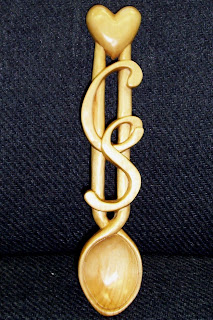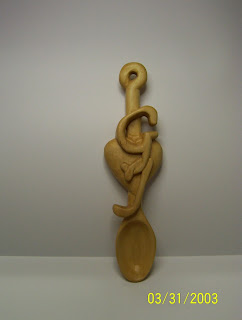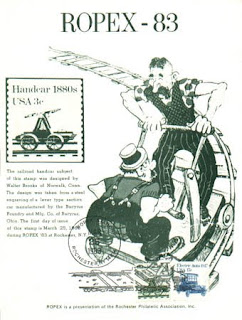Saturday, August 29, 2009
The Guitar-playing Frog
Thursday, August 20, 2009
Hands of Hope
Tuesday, August 18, 2009
"Lettered" Love Spoons and The Mythology of the Linden Tree
I've got my "Lettered" Love spoons to show tonight. There is not too much to say about them. I *could* give you the names of all of the owners but that would probably be a little intrusive. But, without being too specific, I *can* say that:
- one spoon went to a noted (OK, so he's *oldies*) rock star and his wife. (You might not know his name, but you *definitely* would know the group).
- one spoon (that really isn't a spoon) went to a famous actor's helicopter mechanic and his wife (Now, how many people can say that!).
- one spoon went to a couple that shares the same first name.
- one spoon went to a bagpipe playing couple.


 More on the History of Love Spoons and the Linden Tree
More on the History of Love Spoons and the Linden Tree
The names “Linden” in North America, and “Lime” in Britain are both derived from the Germanic, Anglo Saxon and old Norse roots lind, linde and linne.
The Linden was a highly symbolic and hallowed tree in Germanic mythology. The tree was an object of worship since it was associated with Freyja, the guardian of life and goddess of fortune, love and truth. Therefore, her tree was considered the symbol of romance and peace and it often formed the central meeting place of many rural communities. The tree became associated with jurisprudence because it was believed that the tree would help unearth the truth and that no one was able to lie maliciously without attracting Freya’s rage.
Legend has it that it cannot be struck by lightning since Freya is the wife of Wodan, the main god of the Germanic pantheon. It was assumed that the Linden possessed some protective power against evil and catastrophe. A Linden tree in a village was viewed as a benign guardian of anyone who lived there.
After Christianity came to Germany, the Linden’s positive connotation continued. Motherly Freya was subsequently replaced by the Mother of God, so that many trees were rededicated to St. Mary (Marienlinde). In the Slavic Orthodox Christian world, limewood was the preferred wood for panel icon painting because its ability to be sanded very smooth, and for its resistance to warping once seasoned.
Well, that's it for tonight. 'til next time, Keep Makin' Chips
Wednesday, August 12, 2009
The Love Spoons will wait
 This one started when I found this postal first day cover, commemorating the development of the railroad handcar. It seemed like a natural for a carving so here it is.
The title: "Faster! The 5:14 is on THIS track!" implies that the guys may have bitten off more than they can chew. Lester, the tall guy (he looks like a Lester, don't you think?), and Bob, the little guy with the patched pants, have just discovered that what appeared to be an empty track at the beginning of their journey is now anything but empty. You can see that the original artwork shows up as a poster on the fence clearly marked "Post no bills". So who reads signs?
This one started when I found this postal first day cover, commemorating the development of the railroad handcar. It seemed like a natural for a carving so here it is.
The title: "Faster! The 5:14 is on THIS track!" implies that the guys may have bitten off more than they can chew. Lester, the tall guy (he looks like a Lester, don't you think?), and Bob, the little guy with the patched pants, have just discovered that what appeared to be an empty track at the beginning of their journey is now anything but empty. You can see that the original artwork shows up as a poster on the fence clearly marked "Post no bills". So who reads signs?
Monday, August 10, 2009
What is a love spoon?
A love spoon is a decorated wooden spoon. The custom of giving love spoons by a young man to his sweetheart as a token of his love and affection originated in Wales sometime during the 16th century. The earliest known love spoon dates from 1567 and is part of a collection at the Museum of Welsh Life in St. Fagans near Cardiff.
By accepted his gift, the girl accepted the young man’s proposal marriage. So the love spoon became established as a Celtic symbol of love and marriage. As centuries passed, love spoons evolved into gifts exchanged between friends and loved ones for all sorts of occasions.
A love spoon may be very plain or intricately decorated. Usually, it is the handle of the spoon that is the most highly decorated, but occasionally the bowl of the spoon may be elaborately carved as well. Even the most elaborate love spoon is sculpted from a single piece of wood. The type of wood is generally dependent on the location of the carver. However, for the most part, my spoons are carved from a relatively light-colored wood from the Linden tree (plentiful here in the Northeast US) known as “Lime wood” in Britain and “Basswood” here in the States.
Generations of craftsmen have carved symbols into their spoons to represent good luck, the blessing of children, health, wealth, etc. Here are just a few of the of the most common love spoon symbols and their meanings:
Interlocking Chain Links - The linking of two lives, where the number of links referred to number of children or years together
Cross - Faith in One's Life and Home
Flowers - Affection, Courtship or Friendship
Single Heart - Love
Heart Shaped Bowl - Full and Bountiful Life
Celtic Knot - Everlasting love
Leaves or vines - Love Grows
Moving on, in Early America, the love spoon took on yet another meaning. The story goes that when a young man “went a’courtin’ ” to the home of a young lady, her father would often give him a spoon blank before leaving them alone in the parlor. This was, presumably, “to keep his hands gainfully occupied” while he visited. To this day, in some areas of the US, when two young people are romantically involved, they are said to be “spoonin’ ”.
Here are a few examples of my Love Spoons:
Flower and Leaf Love Spoon
Pine, approx. 10” long
This was the third or fourth spoon from this pattern (not originally mine). I have tried to vary the flower design and the shape of the bowl, etc. just to make it interesting. I think this one finally captured what I was going for.
Square Knot Spoon
Basswood, approx. 9” long
Someday I'd like to carve another spoon similar this one but with a slight “Salvador Dali” influence. I want to stretch it and make it slightly less regular in shape.
“Twin-Helix” Spoon
Some sort of pine, approx. 10” long
This was the first of my twisted handle spoons. The handle forms a “twin-helix” a la the DNA molecule. It is a lot of fun to play with. Sliding your hand up or down the handle causes the spoon to spin making it a toy and a spoon.
“Interrupted Twin-Helix” Spoon
Pine, approximately 12” long
I made this one for my brother. This spoon and the last one were cut from opposite ends of the same piece of wood. Even though they were carved and finished the same way, their final coloration is remarkably different. I’m not certain what kind of pine it is but the scent of pine resin was unmistakable.
The most interesting part of this spoon is the back of the bowl. It reminds me of “The Scream” by Edvard Munch. But maybe that’s just me. :-)
Classic Scroll Spoon
Basswood, approx. 9-1/2” long
This was my wife's Valentine's Day present for 2004. I added the script "J" to personalize it. The bowl and hole form a heart within a heart. I am constantly amazed and delighted with the variation in wood color that basswood has.
Next time I’ll go into my “Lettered” love spoons.
Til then, Keep makin’ Chips







